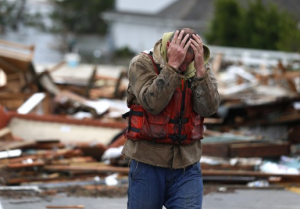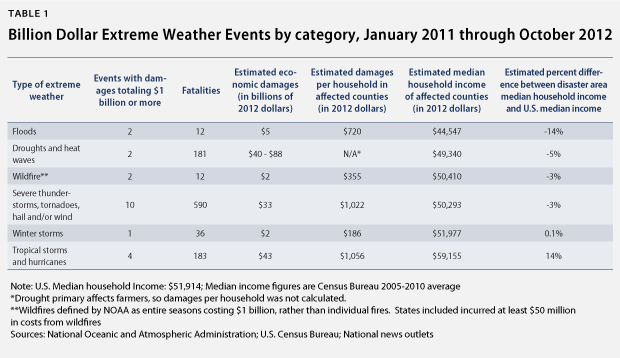Analysis: How Climate Destruction Harms Middle- and Lower-Income Americans
 The devastating and tragic Hurricane Sandy and its connected storms caused a huge swath of destruction in the mid-Atlantic region of the United States on October 29, before then dumping vast quantities of snow in the Midwest. The storm is responsible for at least 110 fatalities in the United States and preliminary estimates indicate that it caused $30 billion in damages, with only one-quarter to one-half covered by insurance. It may be one of the costliest U.S. hurricanes in history.
The devastating and tragic Hurricane Sandy and its connected storms caused a huge swath of destruction in the mid-Atlantic region of the United States on October 29, before then dumping vast quantities of snow in the Midwest. The storm is responsible for at least 110 fatalities in the United States and preliminary estimates indicate that it caused $30 billion in damages, with only one-quarter to one-half covered by insurance. It may be one of the costliest U.S. hurricanes in history.Unfortunately, Sandy is only the latest in a line of extreme weather events that severely afflicted Americans over the past two years. This includes destructive wildfires in Colorado, record-breaking temperatures across the nation, and severe thunderstorms and tornadoes across the Midwest. Farmers in the Great Plains are expecting to harvest just a fraction of their corn and other crops this year as the worst drought in 50 years plagues nearly two-thirds of the nation. Vicious heat waves, wildfires, hurricanes, and severe storms left more than 1,000 people dead. These are the extreme weather events that scientists predict will become more frequent and/or severe if the industrial carbon pollution responsible for climate change remains unchecked.
Scientists and government agencies documented the devastating extreme weather events in 2011 and 2012. The National Oceanic and Atmospheric Administration reported 14 weather events that caused at least $1 billion in damages each in 2011. By our estimates, from January through October 2012, there were at least seven additional extreme weather events with more than $1 billion in damages each, with total damages from the two years combined topping $126 billion. In addition to these events, economists predict that the 2012 drought will cause between $28 billion and $77 billion in damages, potentially bringing the two-year total to $174 billion.
The events during this time affected all but 4 of the lower 48 states. A recent study by Munich Re, the world’s largest reinsurance firm, found that North America is experiencing a tremendous rise in extreme weather disasters-a nearly fivefold increase over the past three decades. The firm concluded that this is due to climate change and that this trend will continue in the future.
One overlooked aspect of these disasters, however, is the rate at which they harm middle-and lower-income households-people who are less able to quickly recover from such disasters. This Center for American Progress analysis finds that on average, counties with middle-and lower-income households were harmed by many of the most expensive extreme weather events in 2011 and 2012. (see Table 1)

Most of these extreme weather events typically harmed counties with household incomes below the U.S. median annual household income of $51,914:
•Floods damaged households in affected counties with average household incomes of $44,547 annually-14 percent less than the U.S. median income
•Drought and heat waves affected counties with households that earned an average of $49,340 annually-roughly 5 percent less than the U.S. median income
•Wildfires, tornadoes, and severe thunderstorms devastated areas with households that earned an average of $50,352 annually-3 percent less than the U.S. median income
In fact, tropical storms and hurricanes were the only types of extreme weather events that affected more-well-off areas, on average, since January 2011.
In the following sections, we review the most damaging extreme weather events in the United States over the past two years, the household income of the counties harmed by them, and how climate change is increasing the frequency and severity of these devastating disasters. We also explain why middle- and lower-income Americans are disproportionately harmed by extreme weather events.
In order to curb climate change and help communities prepare for future extreme weather events, we propose a list of policy recommendations, detailed at the end of this report:
•The Obama administration should promulgate the proposed carbon pollution reduction standard for new power plants
•The administration should propose and promulgate carbon pollution standards for existing power plants and oil refineries
•Existing infrastructure should be hardened to become more resilient to floods, severe storms, and other effects of climate change
•Congress should provide $5 billion annually-full funding-for the Low Income Home Energy Assistance Program, or LIHEAP, to assist low-income families with higher utility bills due to extreme heat and cold
•The Obama administration and Congress should oppose budget cuts in the Supplemental Nutrition Assistance Program to ensure that there is adequate funding for Disaster SNAP that assists people harmed by natural disasters to purchase food
•Congress should reauthorize the National Dam Safety Program and provide $1 billion annually to rehabilitate our rundown dam and levee infrastructure that helps reduce flood risk
•Flood insurance for primary homes of middle- and lower-income households should be more affordable. A means-tested voucher program could help them purchase it
•Replenish the Pre-Disaster Mitigation Program fund, which enables local communities to evaluate their disaster risks and develop plans to make them more resilient to extreme weather damages. This annual funding should equal the three year average of federal disaster recovery spending
You can return to the main Market News page, or press the Back button on your browser.

